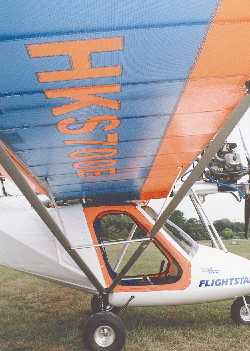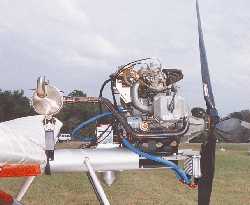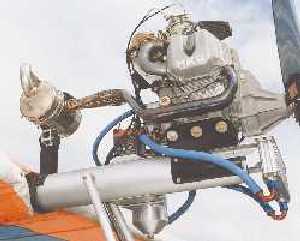
FOUR-STROKER – This bright orange-and-blue Flightstar is pulled around by its twin cylinder 60-hp 4-stroke HKS 700E engine. Flightstar personnel represent the Japanese import in the U.S. under the business name HPower Ltd.

ALL NEW – The HKS has gone through changes that greatly improve the 700E engine from Japan. Though it doesn’t look much larger than some 2-stroke engines, it flies completely differently and it’s quieter than ever (see article).

COMPACT POWER – A small package compared to most 4-stroke choices, the 700E is also less complex to install than some others. HPower personnel (the same as represent Flightstar Sportplanes) have built an enviable customer service reputation.
The 2000 HKS
In a concerted effort to give Rotax a challenge in the U.S. (and the world), the 60-hp 4-stroke HKS 700E engine arrived in America during 1998. Oh, sure, other engine makers including Hirth, Zenoah, and 2si have been in the market longer but they haven’t made a significant dent in the dominance enjoyed by Rotax.
To be honest, neither has the HKS… yet. Any brand-new engine is bound to have teething pains – even from a company that is a well-established purveyor of engine products in the auto industry. Some of the first 100 HKS engines to arrive in the U.S. experienced various minor troubles.
To the enormous credit of HKS and their American partner, HPower Ltd., all those HKS buyers received the same customer service care that Flightstar buyers have long appreciated. In some cases new parts were sent without charge and in all cases, HKS buyers could count on concerned attention from HPower. Thanks to close attention to good service, the engine gains ground everyday.
Changes For a New Millennium
Representing the HKS brand is HPower Ltd., a new company formed by Flightstar principals Tom Peghiny and Spark Lamontagne. They list the changes to the HKS for 2000 that further improve this impressive engine.
· The renewed twin cylinder engine now has a larger diameter oil pump with an additional rotor to scavenge the oil from the heads. Remember this is a 4-stroke engine and oil distribution is not part of the fuel running through the engine.
· Oil flow was increased to the head for greater cooling. Peghiny says this is particularly important for pusher installations, which are so common in the ultralight industry.
· The 2000 HKS now has a larger dry sump for greater angle of attack range. The company says this is again particularly important for pusher installations and it shows they are considering the different performances of ultralights over conventional aircraft. Since ultralights climb at steeper angles of attack – simply compare to any gradual Cessna 150 or 172 climbout – the engine must be able to operate at those sharper attitudes.
· By a combination of numerous internal changes taking into account 3 years of field experience, the 2000 HKS now features lower normal operating and maximum cylinder head temperatures.
· Perhaps the most significant change was one I could notice the most easily in my flight with the new engine on Flightstar’s show plane II SC. The last Flightstar I flew with the HKS (which was the first one HPower fitted) was admirably quiet. That was many ultralights ago for me, but I still noticed how peaceful it was in the new Flightstar II SC with the 2000 HKS engine. Even with headsets removed, conversation was easy without yelling. What a pleasant change from the racket of a 2-stroke engine.
Tom Peghiny says, “Quieter mufflers meet or exceed the European noise standards.” I’ve followed this for a few years and am aware how much more subdued are the European aircraft I’ve flown. In Europe, ultralights may not be louder than 55 decibels at full power at 150 meters (about 500 feet). Since normal conversation is in the 60-decibel range, the noise restriction in Europe is very significant. But I’ll bet it makes for much improved neighbor relations in a part of the world where space is at a premium.
Finally, HPower says that the 2000 HKS 3.47:1 gearbox reduces propeller noise. Peghiny notes that the two points about noise are “something we are going to push.” Sounds smart to me; what pilot would not want his engine to make less noise?
Let’s Get Technical
For more technically aware readers, the 700E features a hydraulic valve train operated by a single cam with cylinder-encased pushrods. And thanks to its improved dry sump lubrication system, either a tractor or pusher installation can be performed, although HPower says inverted installations are not approved.
Fully equipped with oil tank, electric starter, and custom stainless-steel exhaust system, the HKS-700E weighs in at a relatively trim 116 pounds. Most auto engine conversations add significantly more weight.
In addition, the engine’s small size (16 X 24 inches) packages well in many existing aircraft installations and cowlings. To assure better fitting, HPower has been in close conversation with many OEMs in the effort to refine the installation.
An HKS installation is more complex than a Rotax 503, but it is roughly on par with an electric start Rotax 582, says HPower.
The Japanese intense focus on quality shows through a full factory break-in procedure, which saves the builder this duty. Before any engine is shipped to a customer, HKS puts 1.5 hours on each 700E at their Shizouka, Japan plant.
HPower partner Spark Lamontagne reports, “HKS is a technology development company known in all forms of motorsports and the automotive after-market business.” The 20-year-old company has a large and impressive facility and employs 400 workers.


Leave a Reply